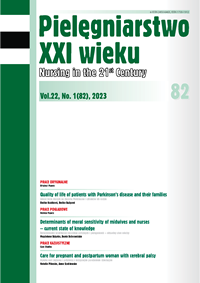Consequences of a lightning strike. Case report with suggested nursing interventions
DOI:
https://doi.org/10.2478/pielxxiw-2023-0005Keywords:
lightning strike, injuries, accidentAbstract
CONSEQUENCES OF A LIGHTNING STRIKE. CASE REPORT WITH SUGGESTED NURSING INTERVENTIONS
Aim. This article is an attempt to describe the case and nursing problems of a sixteen-year-old female patient of Tytus Chałubiński Hospital in Zakopane who was admitted to the paediatric ward on 22nd of August 2019 after being struck by lightning during a hike to Giewont.
Material and methods. The author has also made an attempt to determine problems during the patient’s hospitalization after the accident on the basis of Evidence Base Nursing – a nursing practice based on scientific research.
Results. The phenomenon of a lightning strike leads to numerous negative health effects in the victim. These include direct consequences, such as vital functions abnormalities, injuries to multiple organs, burns, and late complications, such as persistent neurological disorders, consequences of injuries to multiple organs and mental and emotional disorders resulting from direct threat to one’s life and participation in a traumatic event. This paper attempts to describe an event of a teenager being struck by lightning and its medical consequences.
Conclusions. 1. It seems expedient to develop and make available, e.g. in the form of computer programmes, standards for nursing patients after lightning strikes, which would take into account mass accidents. 2. It is necessary to develop and promote a model for hospital organisation of psychological assistance to patients (including adolescents) involved in a mass accident. It should also take into consideration later consequences of traumatic events.
References
1. Janiszewska E. Pierwsza pomoc. Porażenie elektryczne prądem i piorunem. www. oipp.lodz.pl. Access online: 27.04.2020.
2. Cherington M. Neurologic manifestations of lightning strikes. Neurology. 2003; 60(2): 182-185.
3. Ströhle M, Wallner B, Lanthaler M, et al. Lightning accidents in the Austrian alps-a 10-year retrospective nationwide analysis. Scand. J. Trauma Resusc. Emerg. Med. 2018; 26(1): 74. doi: 10.1186/s13049-018-0543-9. PMID: 30201016; PMCID: PMC6131802
4. Conrad L. Clinical update on lightning injuries. Wilderness and Environmental Medicine. 1998; 9: 217-222.
5. Thakur KS, Sonwani NS, Ateriya N. Filigree burns of a lightning strike: A case series. Med. Leg. J. 2021; 89(3): 187-192. doi: 10.1177/00258172211011003.
6. Modayil PC, Lloyd GW, Mallik A, et al. Inner ear damage following electric current and lightning injury: a literature review. Eur. Arch. Otorhinolaryngol. 2014; 271(5): 855-861. doi: 10.1007/s00405-013-2544-7.
7. Roberts S, Meltzer JA. An evidence-based approach to electrical injuries in children. Pediatr. Emerg. Med. Pract. 2013; 10(9): 1-16.
8. Tolunay Oflu A, Kacar E, Pektas A, et al. A rare complication of lightning strike: Pulmonary contusion. North Clin. Istanb. 2020; 8(6): 619-622. doi: 10.14744/nci.2020.24022
9. Watanabe N, Inaoka T, Shuke N, et al. Acute rhabdomyolysis of the soleus muscle induced by a lightning strike: magnetic resonance and scintigraphic findings. Sceletal Radiol. 2007; 36: 671-675.
10. Akın A, Bilici M, Demir F, et al. ST-segment elevation following lightning strike: case report and review of the literature. Turk. J. Pediatr. 2015; 57(2):186-188.
11. Lichtenberg R, Dries D, Ward K, et al. Cardiovascular effects of lightning strikes. Journal American College of Cardiology. 1993; 21(2): 531-536.
12. Rotariu EL, Manole MD. Cardiac Arrest Secondary to Lightning Strike: Case Report and Review of the Literature. Pediatr Emerg Care. 2020; 36(1): e18-e20. doi: 10.1097/PEC.0000000000001255
13. Cristophides T, Khan S, Ahmad M, et al, Cardiac effects of lightning strikes. Arrythm. Electrophysiol. Rev. 2017; 6(3); 114-117.
14. Muehlberger T, Voght P,M, Munster A,M, The long consequences of lighting injuries. Burns. 2001; 27: 829-833.
15. Wankhede AG. A unique case of direct lightning strike. J. Forensic Sci. 2022; 67(3): 1288-1293. doi: 10.1111/1556-4029.14972
16. Cooper MA. Emergent care of lighting and electric al injuries. Seminars In Neurology. 1995; 15(3): 268-278.
17. Yrondi A, DerKasbarian R, Gallini A, et al. Symptoms of depression and post-traumatic stress in a group of lighting strike victims. Journal of Psychosomatic Research. 2019; 120; 90-95.
18. Hyett JM. How to respond when lightning strikes. Nursing. 2009; 39(7): 32-35. doi: 10.1097/01
19. Day MW. Lightning strike. Nursing. 2003; 33(6): 104. doi: 10.1097/00152193-200306000-00069
20. Andres J. Pierwsza pomoc i resuscytacja krążeniowo-oddechowa. Kraków: Polska Rada Resuscytacji; 2011, s. 123.
21. Lederer W, Wiederman FJ, Cerchiari E, et al. Electricity- associated injuries II: outdoor management of lighting-induced casualties. Resuscitation. 2000; 43: 89-93.
22. Slesinger TL, Bank M, Drumheller BC, et al. Immediate cardiac arrest and subsequent development of cardiogenic shock caused by lightning stroke. The Journal of Trauma. 2010; 68(1): 5-7.
23. Turan M, Kalkan F, Bozan N, et al. Isolated Sensorineural Hearing Loss as a Sequela after Lightning Strike. Case Rep Otolaryngol. 2015; 738416. doi: 10.1155/2015/738416
24. Ackley BJ, Ladwig GB. Podręcznik diagnoz pielęgniarskich. Przewodnik do planowania opieki opartej na dowodach naukowych. Warszawa: GC Media House; 2011.
Downloads
Published
Issue
Section
License
Copyright (c) 2023 Author

This work is licensed under a Creative Commons Attribution 4.0 International License.




